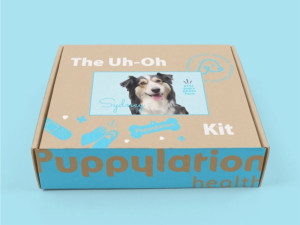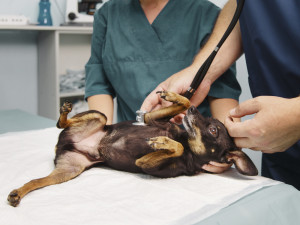Be Prepared: Four Pet Emergency Room Essentials for Pet Parents
Lay the groundwork for quick, low-stress treatment.

share article

Your pet wants you to read our newsletter. (Then give them a treat.)
Working in the ER, I see a full range of preventable predicaments that complicate addressing a pet’s immediate health crisis. Here are four simple measures you can take as a pet parent to prevent distress and concern should an emergency arise while you are away or if you need to seek care outside of your normal veterinary relationship.
1. Keep Your Records Organized
Keep a copy of every medical record, radiograph, and diagnostic test in a file. Doing so allows a new veterinarian to quickly understand your pet’s health status. This is especially important if your pet has a history of illness such as kidney failureopens in a new tab, cancer, or multiple/ongoing disease processes.
Your pet file should also include a copy of vaccination records. I often get last-minute calls to fill out a health certificate for airline travel but am unable to do so because pet parents do not have proof of their pet’s rabies vaccinationopens in a new tab. As is the case with most emergency hospitals, I am unable to administer another vaccine because we don’t keep any in stock (this is an area of health care that is left to general practitioners).
2. Prepare an Advanced Directive
I strongly recommend that every pet parent has an advanced directive in place with regards to their pet’s continued care in the event of physical decline in their absence. This is especially important if you share your life with a geriatric pet or one who has ongoing medical issues or failing health. Discuss with your pet sitter, family members, and your veterinarian your wishes and have a clear understanding of treatment limits in the event you cannot be reached.
I cannot tell you how many times I have seen family members or caretakers struggling to make the difficult decision of euthanasia in the event a pet is suffering and the pet's parents are out of contact.
3. Pre-arrangement Payment Before an Emergency
Along the same lines as an advanced directive, pre-authorization for treatment is strongly recommended. It is not uncommon for pet parents to leave their pets in the care of a boarding facility, an in-home pet sitter, or a family member during vacation, and then something goes wrong. It is heart-wrenching to navigate a situation where the temporary guardian brings in a pet and has no means of payment or way of contacting the pet parents to obtain approval for a treatment plan. We try to work as best as we can with these situations, but you can only imagine how heavy these decisions can be for everyone involved.
A common example is a pet who has been hit by a car. Although severe trauma can have an excellent outcome with treatment, the cost of stabilization and management can quickly reach thousands of dollars. Financial responsibilityopens in a new tab and the decision to pay for this level of treatment is a big burden to place upon your sitter. I would give anything for this to be a world without financial concerns, but the hard reality is that emergency hospitals generally will not extend credit in good faith, especially if you have no previous relationship with them.
So before leaving town, stop by your local emergency clinic and your regular veterinarian to sign a release of payment in case of emergency. Your credit card number can be kept on file with your signature authorizing treatment in event of an emergency; you can also set the parameters of care at that time.
4. Plan Ahead and Anticipate Medication Shortages
I get many calls from pet parents asking to refill a pet’s medication because they are leaving town the next day and their regular vet is closed. What many people are not aware of is that legally we are not able to provide this service unless we perform a full physical examination on the pet, and with that comes the cost of an emergency exam fee.
Although it can be understandably frustrating to have to pay an exam fee for an otherwise healthy pet for a “simple refill” of a medication, legally, hospitals cannot serve the role of a dispensing pharmacy. By law (and risk of our veterinary license), we cannot OK a refill of medication without examining your pet, no matter how benign or common the drug. Because of this, I recommend keeping an extra bottle on hand or getting in the habit of refilling your pet’s prescriptions when the bottle is approaching three-quarters empty.
Another tip: If you fill your medication at a human pharmacy, and it is a drug and dose that stays constant for a well-controlled disease state (such as medicated drops for eye diseaseopens in a new tab or phenobarbital for seizures), ask your veterinarian to write an additional refill on the written prescription.
I hope these four simple proactive steps help raise awareness of potential situations that can arise while you are away and help you to formulate a plan well in advance should any situation unexpectedly arise.

Dr. Shea Cox, DVM, CVPP, CHPV
Dr. Shea Cox is the founder of BluePearl Pet Hospice and is a global leader in animal hospice and palliative care. With a focus on technology, innovation and education, her efforts are changing the end-of-life landscape in veterinary medicine.
Related articles
![uh-oh kit for dogs]() opens in a new tab
opens in a new tabYou Need This Customizable, Vet-Designed First Aid Kit for Dogs
Just in case.
![A dog getting checked out at the vet]() opens in a new tab
opens in a new tabWhat to Expect At the Emergency Vet
It's every pet parent's nightmare — but knowing what happens when you take your dog to the ER can make the experience a little less stressful.
![Uncomfortable looking gray cat sitting on a window sill]() opens in a new tab
opens in a new tabShould Your Cat Go to the ER?
Here are six good reasons to haul tail to the emergency room.
![Man hugs his dog to his face]() opens in a new tab
opens in a new tabHow Will I Know When It’s Time?
End-of-life veterinary specialist Dr. Shea Cox on how to make the most difficult decision in your pet parenting journey.




